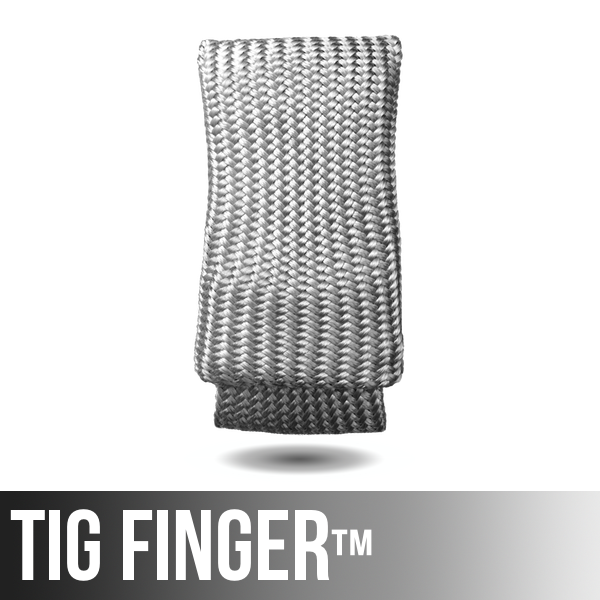
Click here to subscribe to my Video of the Week!
This week’s video is a culmination of a bunch of random welding tasks… All done over the period of a few months using a tig machine that is relatively new on the market.
I did quite a bit of field testing on this unit so over the course of a few months, and I did quite a few odd jobs in addition to testing it out on some really thin stuff like razor blades.
Random Tig Task #1
The most recent job I did was an aluminum part made from 6061t6 3/8″ (9mm) thick bar stock. The ends of the bar stock were damaged from someone removing some tabs that were located in the wrong orientation. My job was to fill in the saw marks, and then weld new tabs on the ends.
I set the machine to 150 amps, 120 hz, and ac balance to 80% EN. Using 3/32″ (2.4mm) 4043 filler and a 3/32″ (2.4mm) 2% lanthanated electrode that was balled a little bit from a previous job. The job would have gone a little better if I would have started out with a sharper electrode welding on those edges, but all in all, things turned out ok.
This was a goofy little job and was done to a drawing that specified welding on three sides with no bevel but I put a small bevel on one side anyway because no weld was allowed on the other side.
Tig Welding Task #2
Boat Prop repair.
I did this video a few weeks ago but decided to include a short clip of it here for those who might have missed it. This is a pretty common repair for boat props of all kinds but if the damage is extensive, or if on an inboard motor setup, pitch blocks, pitch and rake indicators, and balancing equipment is needed.
But I have seen many aluminum boat props like this repaired without balancing. It does require using some type of template to make sure the contour is very close once finished.
On this job, here are the details:
- Amperage was set to around 135, but I probably never got over 80 amps using the foot pedal to control amperage.
- I used a 1/16″ (1.6mm) 2% lanthanated electrode tapered just about like you would for tig welding steel.
- 1/16″ (1.6mm) 4043 filler rod ( 4145 sometimes works a little bit better but I did not have any in the shop).
- AC balance was set to 65% en
- AC frequency was set to 120 to help focus the arc ( 100-120 hz is a very good setting for most jobs)
- I used a #7 gas lens cup with about 15cfh argon flow
(if you are interested on learning more about boat propellor repair, there is a bunch of info at rundquist.com.)
Tig Task #3
This job was also in a video just a few weeks ago. A chunk of stainless steel that was accidentally machined wrong. Not any extra material on hand and the job needed to be delivered in a day. So setting the machine to DCEN and only around 90 amps I ran several beads until there was enough metal to machine the part to the correct shape and dimension. I used er308L filler metal and a #7 gas lens and 15 cfh argon and a 3/32″ (2.4mm) 2% lanthanated electrode.
Tig Task #4
Razor blades… or rather utility knife blades. These blades around .025″ thick. That’s about .6mm. But since I welded a corner joint on the sharp edge, it’s like welding thinner metal. The powertig 210ext has a start adjustment in a hidden menu so you can set it low to light up on really thin stuff like razor blades.
I think I set the amperage to about 25 and just used the foot pedal to control amps while welding.
One thing to be learned from this clip is that by using aluminum angle to back up the weld, it comes out pretty shiny on the back side. Almost as good as if it were shielded with argon. Copper works even better.
Tig Task #5
.500″ 12mm thick 4140 bar stock lap joint. I did this in 2 passes with the machine set to 150-160 amps. 3/32″ er70s-2 filler rod and 3/32″ (2.4mm) 2% lanthanated electrode using a #7 gas lens with argon set to 15 cfh.
If this had been a real part, a preheat would be needed because 4140 is a hardenable steel.
Tig Task #6
A bearing sleeve welded inside a roller. Same settings and filler rod as task #5.
Tig Task #7
Welding some stainless bar stock to some carbon steel nuts.
For this job I used pulse settings just for kicks.
39 pps, 33% pulse on time, and 33% background current
er309L filler rod.
Tig Task #8
When I am field testing a machine, I usually run several beads back to back on a piece of aluminum.
It’s good practice for me, and it’s also a good way to experiment with different settings on the macine.
One setting this machine has that is unique is an advanced pulse setting. The current actually switches from AC to DCEN as it pulses.
You don’t get any cleaning action on the Electrode negative cycle but the shielding gas prevents the puddle from oxidizing and the dcen current keeps the part hot.
It’s an interesting feature that is said to help on thin aluminum sheet but I bet someone will find other applications. For me, it seemed to work very on thick aluminum.
Tig task #9
A flat 1g butt joint square groove weld.
125 amps 120 hz ac balance set to 70% en
3/32″ (2.4mm) 4043 filler and a 3/32″ (2.4mm) 2% lanthanated electrode that was tapered.
Notice the technique in this video. I lengthen the arc while I add filler and keep it tight while I step ahead. If you hare having trouble with the electrode touching the puddle while you add rod, you might give this technique a try.
==============
Well, that’s 9 random tig welding tasks for you today.
Peace Out.
( As always, feel free to visit us at our sister site, WeldingTipsAndTricks.com. )
Click here to subscribe to my Video of the Week!








November 7, 2012 at 7:29 PM
Hola jody saludos desde mexico, e estado viendo sus videos y te la sabes men ,gracias por compartir su conocimiento y por la invaluable tarea que realiza.
November 7, 2012 at 12:43 AM
I’ve been watching your videos for a few months now and they are outstanding. I’ve tried to TIG weld for a few hours (about 80 hours in total and I still suck at it) and I would like to know how you hold and advance the rod in your gloved hand. I notice that you use some interesting smooth leather gloves instead of the split leather types and I’m wondering why. I’ve tried many different types of gloves. I was told to practice advancing the rod by ratcheting my thumb and I haven’t taken this to heart. When I try it, the tip wanders all over the place. Can you show us how your hands are working together in more detail. I love the videos of what the puddle and its relationship to the tips of the rod and electrode are, but I would like to see more of how you are moving beyond the close-up camera. Thanks,
Dave
November 7, 2012 at 12:43 AM
As always Jody,your da Man!